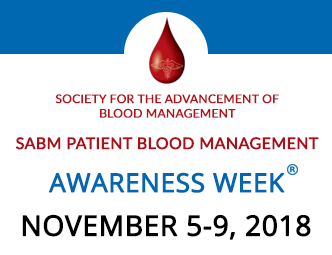JULY 2018
ISSUE

Please consider making a donation to your Society. Your donations will help us to improve the lives of people throughout the world through Patient Blood Management.
SABM 2018 Newsletter Publication Schedule
March | July | November
Carolyn Burns, MD
Editor
Tiffany Hall, RN
Associate Editor
Sherri Ozawa, RN
Kevin Wright
Contributors for This Issue
Nabil Hassan, MD
Stacey Valentine, MD
Brian Boville, MD
Susan Goobie, MD
Marketing & Membership Services
Carmen Melseth
SABM Officers and
Directors
|
Standards Showcase
STANDARD 13: Patient Blood Management for Pediatric Patients
For hospitals that treat pediatric patients, there are age-appropriate evidence-based patient blood management clinical strategies, policies and procedures in place. Patient Blood Management is available to all pediatric patients.
An important part of a comprehensive PBM program is developing pediatric specific PBM modalities to reduce the risk of transfusion and to optimize transfusion when clinically indicated. Because neonates, infants and children are physiologically distinct from adults, adult transfusion guidelines can not be uniformly applied to pediatric patients. Transfusing pediatric patients unnecessarily can expose them to increased risk without benefit. Pediatric age patients may be more tolerant of severe anemia if they have normal cardiopulmonary function and may tolerate lower hemoglobin transfusion thresholds.
Indicator 13.1 states: There are clearly defined and accepted definitions for neonates, infants, pediatric and adolescent patients based on age and weight that delineate categories within neonatology and pediatrics for the purposes of patient blood management. Caregivers and hospitals should reach a consensus on these definitions prior to the establishment of specific age and weight related guidelines.
Indicator 13.2 states: Transfusion guidelines for all blood components are weight and age appropriate, are based on both laboratory and physiologic/clinical criteria and use restrictive transfusion thresholds when supported by published evidence and expert consensus.
The Pediatric Critical Care Transfusion (TAXI) and Anemia Expertise Initiative recently completed a two-year international expert consensus series to develop evidenced-based and when evidence was lacking, expert-based recommendations for red blood cell transfusion decision-making and future research. TAXI brought together 42 experts, spanning 8 medical specialties from 8 counties to develop 45 clinical recommendations and 57 research recommendations, for red blood cell decision-making in critically ill children, further supporting restrictive transfusion thresholds. These recommendations are currently in press in Pediatric Critical Care Medicine.
Additional studies, from around the globe, continue to contribute to the body of evidence that neonatal and pediatric patients can be supported through acute and chronic illness with a multitude of PBM strategies.
SABM is recognized as the leader in Patient Blood Management. The SABM PBM Standards assist practitioners and institutions that wish to establish a formal organization-wide comprehensive patient blood management program. These Standards should be used to accelerate adoption of evidence-based practices and clinical guidelines in any institution, bringing proven treatment and management strategies that improve patient outcomes at the bedside.
Contributor: Stacey L. Valentine, MD
Assistant Professor Pediatrics, University of Mass. Medical School
|

Donna Shaw, co-author of Blood on Their Hands, is speaking on this fascinating subject at the SABM 2018 Annual Meeting.

The Society for the Advancement of Blood Management (SABM)
invites healthcare organizations worldwide to participate in this week dedicated to educating patients and healthcare professionals about patient blood management.
FOLLOW US ON INSTAGRAM

© 2018 Society for the Advancement of Blood Management
350 Engle Street Englewood, NJ 07631 USA Phone: (928) 551-6400 Fax: (877) 944-2272 EMAIL: [email protected] |